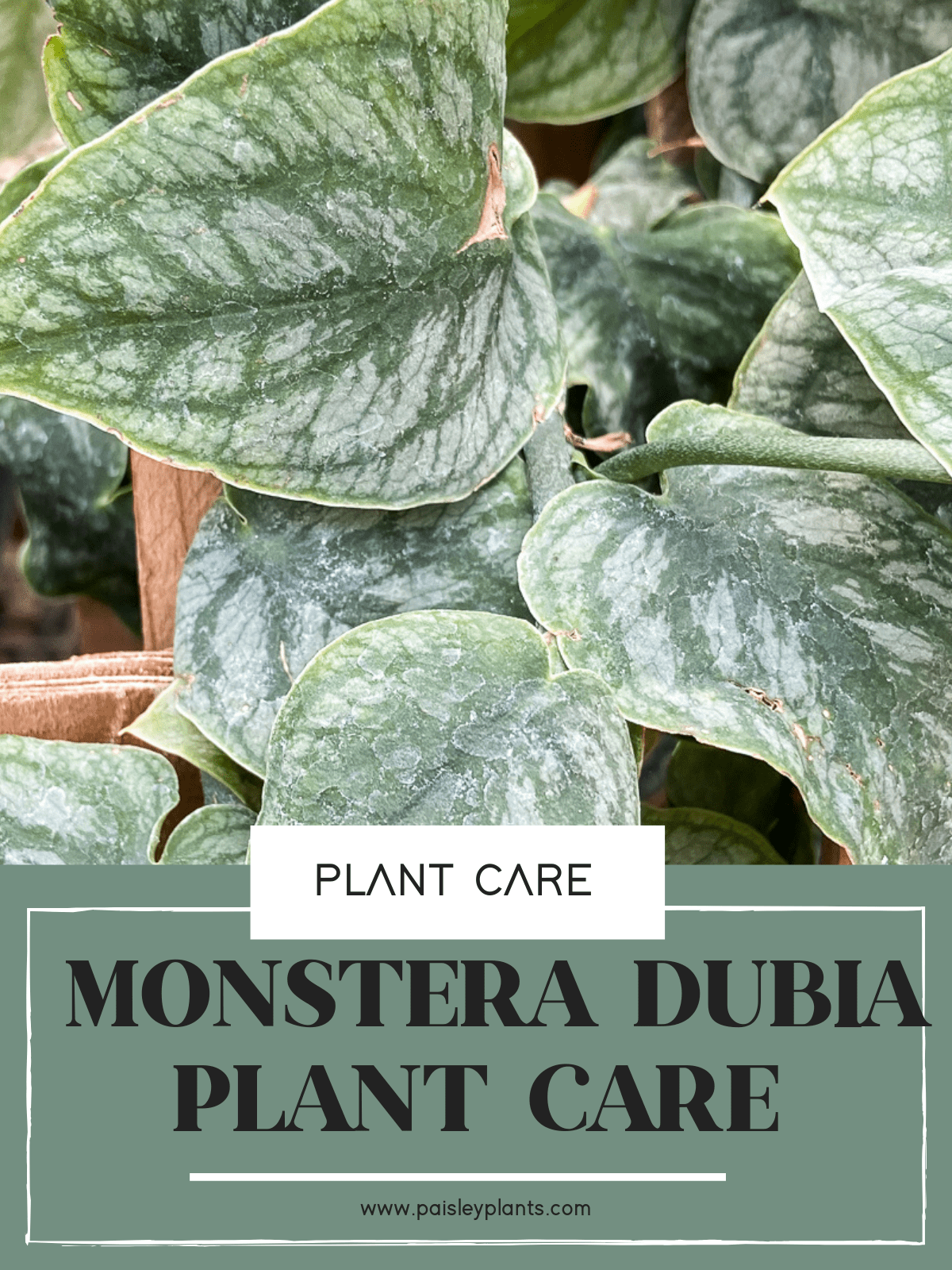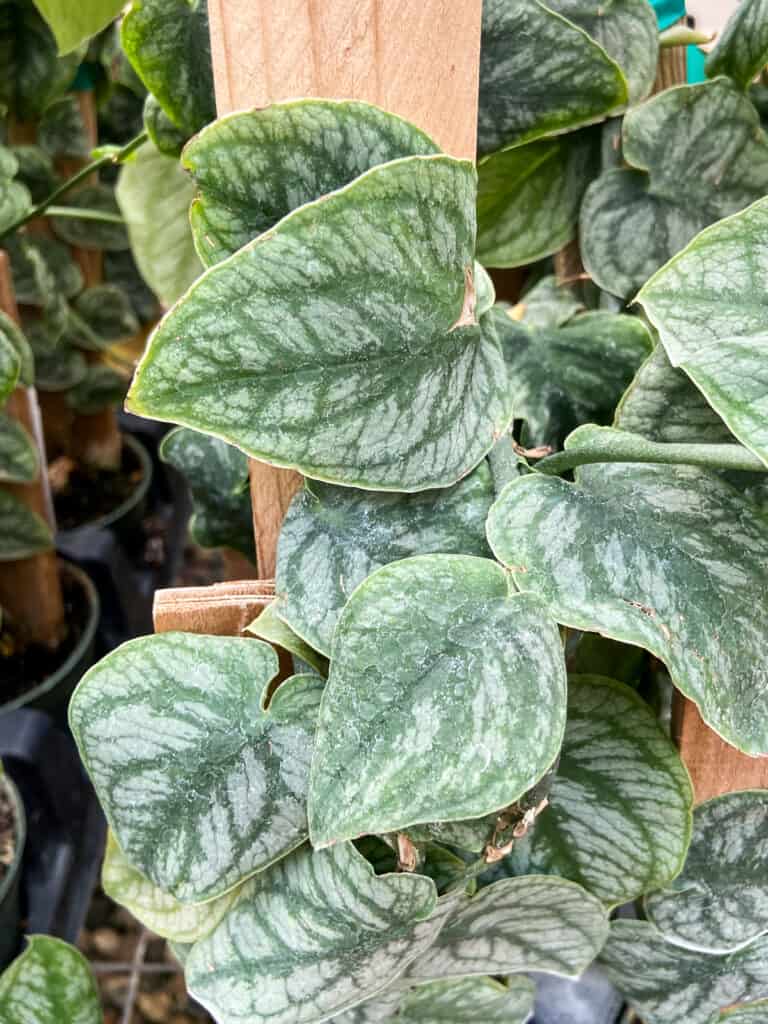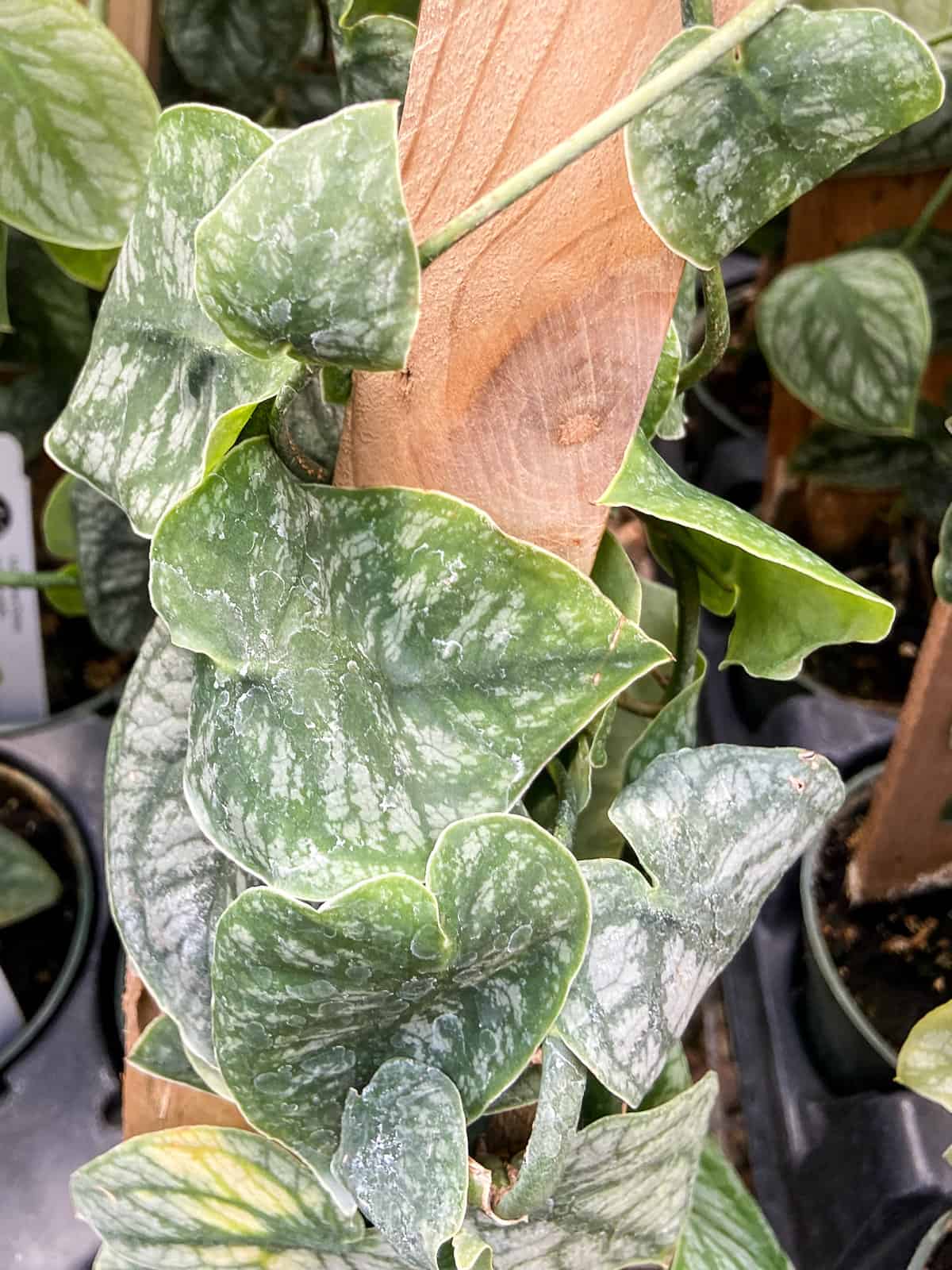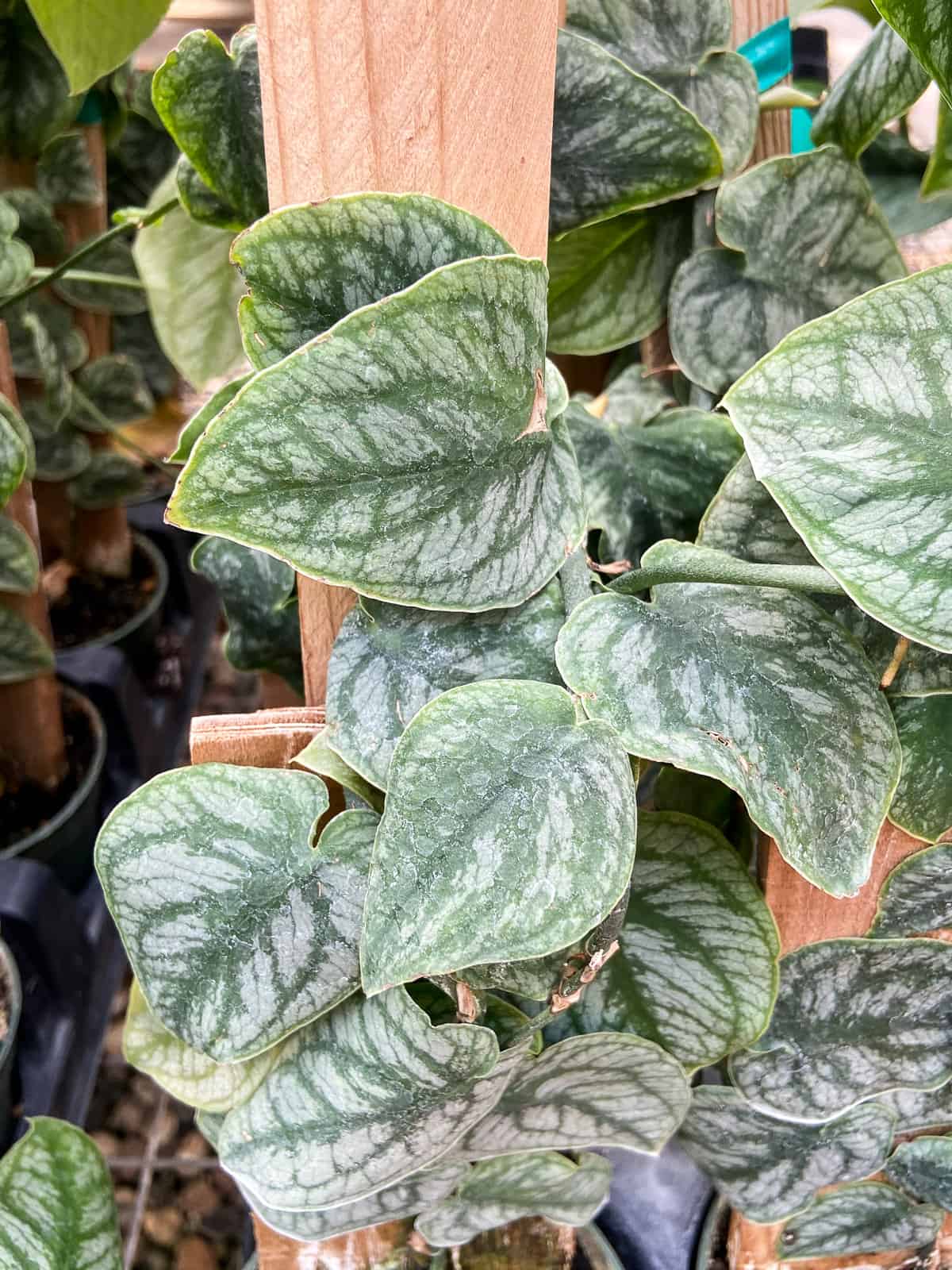Beautiful, rare, low-maintenance: the Monstera dubia checks all three boxes. If you have your hands on one of these tropical plants, then count yourself as one of the lucky ones!
The Monstera dubia is very rare, so it is important to give them the best care. Read on for this ultimate care guide to the Monstera dubia.

Table of Contents
Background
One of the rarer members of the Monstera genus, the Monstera dubia is a unique and eye-catching tropical perennial. They sometimes go by the common name “Shingle or Shingling plant” because of how they lay flat against trees and other surfaces as they grow.
The Monstera dubia is originally native to the tropical rain-forests of Central and South America, where they naturally climb on trees and larger plants. The monstera dubia is a very rare monstera species, and you might have to rely on a private seller to obtain one of these beautiful plants. I have started to see them more often at local plant stores and through online sellers as well although they seem to sell quickly!
Most Monstera dubia that you see in households are often juveniles. They are identifiable by their small, heart-shaped green leaves with dark green variegations. Juvenile Monstera dubia leaves tend to grow flat against whichever climbing structure they are growing on.
In stark contrast, mature Monstera plants are often seen in the wild, where they bear a closer resemblance to the more common deliciosa species. As these plants grow taller, they reach the tops of the canopy and into full sun.
This will take them from will turn a deep green and develop large fenestrations. These mature plants have no variegation and their large leaves hang from the vines, as opposed to growing flat. You won’t likely see this transformation happen indoors so don’t expect that if you own one!
While the Monstera dubia is an exceptionally beautiful plant, they are unfortunately toxic to both pets and humans. If you do own one of these plants, it is best to exercise extreme caution and keep this out of reach from furry friends and curious kids.
Monstera Dubia Care

Here’s all the Monstera dubia care tips you need to know!
Climbing
One of the main things you need to know about the Monstera Dubia is that it’s a climbing plant, as we mentioned above.
Because of this, you’ll want to provide some sort of way for the Dubia plant to climb up like it does in nature through a plant or moss pole (or anything else).
Sun & Light
The Monstera dubia plant is native to tropical rain forests where they grow under the dappled shaded light of the forest canopy.
In your home, you can help recreate this environment by providing bright, indirect light to your plant. Avoid exposing your Dubia plant to extended periods of direct light, as this can have negative effects on young plants.
Soil Type
The ideal soil for a this plant to grow in should be both well-draining and moisture-retentive soil. When you’re shopping for a potting soil for these plants, select a chunky arid soil mixture.
You can also mix your own soil for your plant by combining equal parts of orchid bark, peat moss/coco coir, and perlite. Avoid using a standard potting soil; it can become too heavy and dense for the dubia plant’s delicate root system.
Water
A good rule of thumb when watering this type of Monstera plant is to wait until the top few inches of soil has dried before watering the soil. While the Monstera Dubia is capable of tolerating slight drought, it should not be left to dry out very often.
When you water your Dubia plant, make sure you are watering it deeply, allowing for excess water to pass through the bottom holes.
I like to do the finger test if I’m not sure if my plant needs water or not. If you stick your finger into the top few inches of soil of your plant and the soil feels dry and no soil sticks to your finger, it’s time to water it. However, if your finger holds some soil on it or it feels wet to the touch, don’t water your plant!

Fertilizer
This Monstera plant is a moderate feeder and will greatly benefit from a regular fertilizer routine. Three times a year, treat your monstera dubia plant with a slow-releasing fertilizer. In addition, you should use a weak houseplant fertilizer once a month during the spring and summer to accelerate your plant’s growth.
Temperature & Humidity
As a tropical plant, the Monstera dubia plantadores warm, humid weather. The ideal temperature range for these plants is between 65° to 80° F, which is more than attainable for inside the household.
Do not place your monstera dubia in an area where the temperature might dip below 65° F, such as near a drafty window or an air conditioning vent.
The humidity level in your home should be at least 50% to maintain a good environment for your monstera. If you are concerned about having a dry home, then introducing an electric humidifier is an easy fix to raising your humidity levels.
Pruning & Maintenance
While you don’t have to prune the Monstera dubia very often, it is always important to prune any foliage that is dead or damaged. Doing so will allow your plant to focus its energy on developing new, healthy growth rather than trying to sustain dead growth.
Always make sure to use sterilized pruning shears before cutting into your Monstera Dubia. Wiping your shears with rubbing alcohol is a quick and effective method of cleaning your equipment.
Choosing a Container & Repotting
The most important aspect of selecting a pot for your monstera is drainage. The pot that you select should have multiple holes at the bottom. These are a necessity for most plants because they allow excess moisture to pass out from the container. This helps keep your plant comfortably moist, but not waterlogged.
You should repot your monstera dubia as soon as you see roots beginning to poke out of the bottom holes; monstera plants do not enjoy being root bound, they require space to stretch their roots. When repotting your plant, place it in a pot that is only slightly larger than the previous.
How to Propagate Monstera Dubia

Like most other monstera plants, the Monstera dubia propagation can easily be done via stem cuttings. The Monstera dubia plant is an exceptionally rare and expensive houseplant; luckily propagating monstera dubia are very easy so you can create more monsteras to keep to yourself, or gift to your loved ones.
Steps for Propagating Monstera Dubia
Follow these straightforward steps to propagate monstera dubia plants through stem cutting:
- The best time to propagate your Monstera plant through stem cutting is during the spring, just before it enters the active growing season.
- Take a healthy stem cutting from your plant. This cutting should have at least two leaves intact and be between 4 to 7 inches long.
- You’ll want to leave the cutting out in a warm location of the home and allow the cut-end part of the stem to dry out. It will take about one week for the stem cutting to callous over.
- Prepare a plant pot that is filled with well-draining potting mix. Make sure the potting mix is evenly moist, but not soggy.
- After the stem cutting has calloused, plant the cut-end of the stem in the potting mix. The leaves should remain above the soil to allow for airflow.
- Keep the plant in a location with bright, indirect light and care for it as you would with a regular monstera dubia.
Common Pests
The Monstera dubia plant is prone to two specific types of houseplant pests; spider mites and scale. Both of these sap-sucking pests can pose an incredible nuisance to both you and your plant.
Early detection is key in controlling both pests; I highly recommend inspecting your plant weekly for any signs of pests. You may not be able to see spider mites due to their tiny size, though they leave behind yellow stippled marks on your plant’s leaves.
Both pests can be curtailed by spraying your plant with neem oil, which is a natural, yet effective insecticide. Mix equal parts water and neem oil and spray the afflicted plant; the neem oil will suffocate any pests that are on the plant.
Be sure to spray both the soil and the leaves (top and bottom of your leaves). Repeat this for the new few days and your plant should be pest-free.
In addition, it is important to prune any leaves that has been damaged by the pests. Pruning damaged leaves not only allows your plant to create new growth, but also prevent the spreading of residual bacteria that can be spread via pests. Completely dispose of any affected leaves; do not place it in a mulch pile.
Common Diseases
While the Monstera dubia plant enjoys moist, humid conditions, it should be noted that they are susceptible to root rot. Root rot can be caused by a variety of reasons, but it all boils down to excess moisture becoming trapped in the soil, which causes the roots to break down and rot.
When the roots become corroded, you may notice brown spots appearing on your dubia. If left untreated, this can be certain death for your plant.
Fortunately, root rot on your Dubia can be remedied with easy, straightforward steps. Here’s how to save your Dubia plant from root rot.
- Remove your plant from its pot and gently shake away excess soil.
- Inspect the roots; rotted roots are mushy and black compared to the firm, off-white color of healthy roots.
- Take a sterile pair of scissors and cut off any rotted roots you see.
- Repot your plant using clean, new soil in a pot that has drainage holes.
Where to Buy
There are many places that the Monstera Dubia are sold! Here’s a few places to shop:
FAQ
Yellow leaves is a good sign that you’re giving your plant too much water and that water isn’t able to pass through the soil. An excess of water can turn your leaves yellow and they’ll start dying off. Eventually it could kill your plant.
Yellow leaves on your Dubia plant could also mean that it needs more nutrients. This can be easily changed through plant food or a fertilizer.
Yellow leaves won’t ever turn green again so your best bet is to just trim them off.
On the other hand, your Dubia plant may have wilting leaves. Wilting leaves usually means it’s not getting enough water. Double checking when and how much water your plant gets can help easily remedy this problem.
Also keep an eye on humidity levels that your plant is getting. These plants love moisture in the air.
Yikes! Brown spots on your Dubia plant’s leaves can mean there is root rot. This is caused by too much water. You’ll want to remove your plant for the soil to check on the leaves. Black or dark brown leaves that are mushy is a clear sign of root rot and they’ll need to be removed.
If there are still healthy roots, keep those and re-pot it back into fresh soil. Then do your best to not over water it!
Like yellow leaves, the brown spots on your Dubia plant’s leaves won’t turn green again so go ahead and trim off any leaves that have gotten discolored.
Not at all. While the dubia is a very rare plant, it is in no way a difficult plant to care for. A Dubia plant is very similar to other members of the same genus. As long as you maintain the proper environment, then your plant will live a happy, healthy life.
When grown indoors, a mature Monstera dubia plant will only grow to roughly 3 feet in length. This is a fraction of its wild, outdoor counterpart; in nature, a Monstera dubia can grow to a staggering 10 feet tall.
Monstera Dubias are truly the star plants of the Monstera genus. They are a unique, compact, and very easy to take care of houseplant. I hope this plant care guide post helps you to successfully grow and care for your own Dubia plant!
If you’re fortunate enough to own a Monstera dubia, then you’ll want to make sure these plants are given five-star care!
Find other Monstera plant care posts here!

